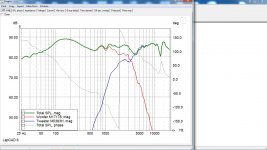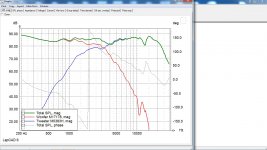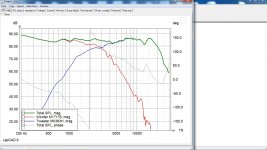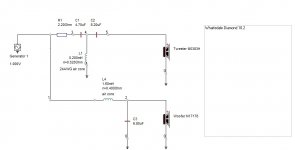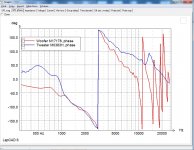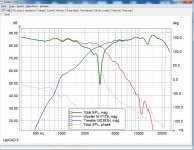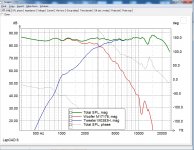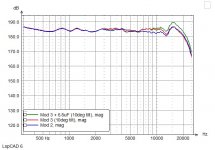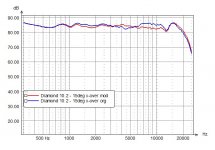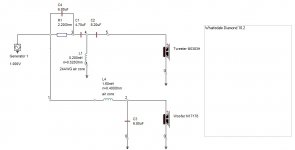Hi Goran,
Did you get a chance to look at the measurements in the pdf file?
Do you see something obviously wrong?
Something seems more off on the HF XO. Is it possible that the minor differences with respect to original parts of the resistance values of the high quality components affects their impedance value with frequency and hence the slope behavior of the XOs?
Also is it possible for the changes to have increased the distortions?
So here are somethings i will pursue based on your input
1. Make measurements
2. Rework the acoustic stuffing
3. Checking wiring polarity
4. check the quality of all contacts and solder
5. reverse tweeter polarity?
thanks
joji
Hi Joji,
Your measurement doesn’t look that different from mine, but you said you made the measurement at 1m on-axis at tweeter height?
You have truncated the measurement to about 550Hz, but you should be able to truncate it down to somewhere 250-300Hz in that setup, depending on the nearby reflecting surfaces e.g. ceiling, floor and sidewalls.
In your measurement picture everything below 550Hz can be ignored and the scale doesn’t make it so easy to see the frequency plot.
Next time in a similar measurement setup, truncate down to at least 300Hz and change the frequency scale to show 200-30000kHz.
I’ve attached some pictures to show how different scales change the look of the frequency response:
Pic1 - Original x-over on-axis @ 1m with your frequency scale.
Pic2 - Original x-over on-axis @ 1m with my frequency scale
As you can see, the Pic1 looks rather like your measurement besides the truncation, which is 275Hz in my case.
The original x-over design isn’t better than this. The mid-woofer x-over section is fine and it has a smooth roll-off following with an estimated LR4 topology with a target x-over point at about 3kHz. The tweeter on the other hand has a resistor to adjust the tweeter level and an electrical second order filter section that poorly integrates with the mid-woofer and mostly only helps the tweeter not to break when listening to the speaker.
At 1m distance at tweeter height the mid-woofer and tweeter doesn’t sum up well and at the x-over point it’s almost out of phase. The drivers relative acoustical offset is rather large to be compensated for in the x-over, but as you can see in Pic 3 it looks better at a 3m distance and at 15deg off-axis where the frequency response is smoother.
Still it doesn’t have an optimal phase behavior around the x-over frequency. What they should have done was to use a stepped or slanted baffle to adjust the drivers relative acoustical off-set in combination with a steeper tweeter filter.
This would of course make the speaker a lot more expensive to manufacture, hence why it’s not done in this budget speaker.
I think you can try to put the speaker upside down and have the mid-woofer at ear height. This would possibly smooth out the 15deg off-axis response even further. It’s worth a try….
Regards
/Göran
Attachments
Last edited:
Hi Joji,
Your measurement doesn’t look that different from mine, but you said you made the measurement at 1m on-axis at tweeter height?
You have truncated the measurement to about 550Hz, but you should be able to truncate it down to somewhere 250-300Hz in that setup, depending on the nearby reflecting surfaces e.g. ceiling, floor and sidewalls.
In your measurement picture everything below 550Hz can be ignored and the scale doesn’t make it so easy to see the frequency plot.
Next time in a similar measurement setup, truncate down to at least 300Hz and change the frequency scale to show 200-30000kHz.
I’ve attached some pictures to show how different scales change the look of the frequency response:
Pic1 - Original x-over on-axis @ 1m with your frequency scale.
Pic2 - Original x-over on-axis @ 1m with my frequency scale
As you can see, the Pic1 looks rather like your measurement besides the truncation, which is 275Hz in my case.
The original x-over design isn’t better than this. The mid-woofer x-over section is fine and it has a smooth roll-off following with an estimated LR4 topology with a target x-over point at about 3kHz. The tweeter on the other hand has a resistor to adjust the tweeter level and an electrical second order filter section that poorly integrates with the mid-woofer and mostly only helps the tweeter not to break when listening to the speaker.
At 1m distance at tweeter height the mid-woofer and tweeter doesn’t sum up well and at the x-over point it’s almost out of phase. The drivers relative acoustical offset is rather large to be compensated for in the x-over, but as you can see in Pic 3 it looks better at a 3m distance and at 15deg off-axis where the frequency response is smoother.
Still it doesn’t have an optimal phase behavior around the x-over frequency. What they should have done was to use a stepped or slanted baffle to adjust the drivers relative acoustical off-set in combination with a steeper tweeter filter.
This would of course make the speaker a lot more expensive to manufacture, hence why it’s not done in this budget speaker.
I think you can try to put the speaker upside down and have the mid-woofer at ear height. This would possibly smooth out the 15deg off-axis response even further. It’s worth a try….
Regards
/Göran
Hi Goran,
Thanks for the detailed explanations. I will try to find some time to work on some of the directions this weekend. Will update you.
All your help is much appreciated.
regards
Joji
Hi Goran,
Thanks for the detailed explanations. I will try to find some time to work on some of the directions this weekend. Will update you.
All your help is much appreciated.
regards
Joji
Hi Joji,
I'm about to embark on the crossover mods also, so I'm following your journey with interest! One thing that tripped me up when I was making measurements on the existing crossover is that I forgot that the speaker is set up for bi-wiring, and that the shorting of the two grounds and tweeter / midrange is done on the outside of the speaker at the terminals. When I removed the crossover from the speaker that also removed the shorting jumpers. Once the lightbulb went on, things started to make more sense.
Anyway, just a thought.
Best,
Ben
Hi Joji,
I'm about to embark on the crossover mods also, so I'm following your journey with interest! One thing that tripped me up when I was making measurements on the existing crossover is that I forgot that the speaker is set up for bi-wiring, and that the shorting of the two grounds and tweeter / midrange is done on the outside of the speaker at the terminals. When I removed the crossover from the speaker that also removed the shorting jumpers. Once the lightbulb went on, things started to make more sense.
Anyway, just a thought.
Best,
Ben
Hi Ben,
Good to know you have set out on this experimentation. Goran's documentation on this project is excellent. But i will be happy to share my experience as well.
All the best, keep us posted.
tha
Hi Goran,
Busy weeks at work. Unfortunately i haven't been able to get to the measurements.
However i was able to do some experiments over the weekend and wanted to update you on the results.
1. By reworking the stuffing inside the cabinets, i was able to restore the sound quality. I had clearly overstuffed the cabinets, though i hadnt expected the effect to be this dramatic.
2. Anyway, i still noticed that one of the speakers was off. The sound though improved after step 1, still seems distant and subdued.
3. I used the biwiring terminals to do some critical listening of my favorite track with just the woofers and then with just the tweeters.
4. The Woofers were very well matched, however I could readily pick out the mismatch between the HF on the two speakers.
5. This got me really confused and concerned, i worried if the crossover components mismatched or if the cabinets were still responsible.
6. To further debug, i removed the tweeters and exchanged them between the speakers
7. The bad sound moved with the tweeter. This confirmed to me that the crossovers (and cabinets??) are probably well matched and there is mismatch between the stock tweeters.
Next steps:
1. I want to reconfirm my observation by swapping the tweeters again
2. Make the measurements according to your recommendations (Need time and Wife's permit to convert my living room into a pseudo anechoic chamber ;-) )
3. See if i can procure a replacement tweeter from Wharfedale
On point 3, do you think it might be possible for me to get in touch with Wharfedale US to request for a replacement tweeter?
Please stay tuned.
thanks
Joji
Busy weeks at work. Unfortunately i haven't been able to get to the measurements.
However i was able to do some experiments over the weekend and wanted to update you on the results.
1. By reworking the stuffing inside the cabinets, i was able to restore the sound quality. I had clearly overstuffed the cabinets, though i hadnt expected the effect to be this dramatic.
2. Anyway, i still noticed that one of the speakers was off. The sound though improved after step 1, still seems distant and subdued.
3. I used the biwiring terminals to do some critical listening of my favorite track with just the woofers and then with just the tweeters.
4. The Woofers were very well matched, however I could readily pick out the mismatch between the HF on the two speakers.
5. This got me really confused and concerned, i worried if the crossover components mismatched or if the cabinets were still responsible.
6. To further debug, i removed the tweeters and exchanged them between the speakers
7. The bad sound moved with the tweeter. This confirmed to me that the crossovers (and cabinets??) are probably well matched and there is mismatch between the stock tweeters.
Next steps:
1. I want to reconfirm my observation by swapping the tweeters again
2. Make the measurements according to your recommendations (Need time and Wife's permit to convert my living room into a pseudo anechoic chamber ;-) )
3. See if i can procure a replacement tweeter from Wharfedale
On point 3, do you think it might be possible for me to get in touch with Wharfedale US to request for a replacement tweeter?
Please stay tuned.
thanks
Joji
Last edited:
Hi Goran,
Busy weeks at work. Unfortunately i haven't been able to get to the measurements.
However i was able to do some experiments over the weekend and wanted to update you on the results.
1. By reworking the stuffing inside the cabinets, i was able to restore the sound quality. I had clearly overstuffed the cabinets, though i hadnt expected the effect to be this dramatic.
2. Anyway, i still noticed that one of the speakers was off. The sound though improved after step 1, still seems distant and subdued.
3. I used the biwiring terminals to do some critical listening of my favorite track with just the woofers and then with just the tweeters.
4. The Woofers were very well matched, however I could readily pick out the mismatch between the HF on the two speakers.
5. This got me really confused and concerned, i worried if the crossover components mismatched or if the cabinets were still responsible.
6. To further debug, i removed the tweeters and exchanged them between the speakers
7. The bad sound moved with the tweeter. This confirmed to me that the crossovers (and cabinets??) are probably well matched and there is mismatch between the stock tweeters.
Next steps:
1. I want to reconfirm my observation by swapping the tweeters again
2. Make the measurements according to your recommendations (Need time and Wife's permit to convert my living room into a pseudo anechoic chamber ;-) )
3. See if i can procure a replacement tweeter from Wharfedale
On point 3, do you think it might be possible for me to get in touch with Wharfedale US to request for a replacement tweeter?
Please stay tuned.
thanks
Joji
Yes, unfortunately the tweeter is the weakest point in this loudspeaker. I wish they had spent a few dollars more to at least have better quality control.
I don't know how Wharfedale handles spare parts in US or if you have to go through a Wharfedale reseller as I did to replace the faulty parts.
Regards
/Göran
Hi Goran,
Another question out of curiosity.
We achieved the 6uF capacitor on the tweeter XO using two parallel caps of 3.3 and 2.7 uf. The ESR of these higher quality caps in parallel may differ significantly from the ESR of the stock electrolytic cap. Would I be correct in saying that this would only have an effect on the tweeter level or could this also influence the XO slope?
thanks
Joji
Another question out of curiosity.
We achieved the 6uF capacitor on the tweeter XO using two parallel caps of 3.3 and 2.7 uf. The ESR of these higher quality caps in parallel may differ significantly from the ESR of the stock electrolytic cap. Would I be correct in saying that this would only have an effect on the tweeter level or could this also influence the XO slope?
thanks
Joji
Hi Goran,
Another question out of curiosity.
We achieved the 6uF capacitor on the tweeter XO using two parallel caps of 3.3 and 2.7 uf. The ESR of these higher quality caps in parallel may differ significantly from the ESR of the stock electrolytic cap. Would I be correct in saying that this would only have an effect on the tweeter level or could this also influence the XO slope?
thanks
Joji
Hi,
You shouldn't worry about that! Yes the caps you are using probably has lower ESR than the original ones, but nothing that will affect the x-over.
On the other hand if you want to fine tune the tweeter level, simply use a resistor between 1.8-2,7 Ohm and see what you like.
Regards
/Göran
Hi Göran,
I just got a pair of Diamonds 10.1 and decided to open them after seeing your review.
I also found poor attention to detail inside. The crossover seemed connected correctly at least on the speaker I looked in. Will open the other one when I have the replacement parts.
The wool was just shoved in and isn't the correct size. There's lots of unsealed seams inside. Have to use filler everywhere.
There was also an insulating pad sitting between the speaker and crossover. It has a sticking side that still had the protecting layer on. I had to take it off and stick it myself.
Crap assembly, not gonna bother with this brand in the future.
Although they look/sound nice.
http://www.diyaudio.com/forums/multi-way/272143-inside-wharfedale-diamond-10-1-a.html
I just got a pair of Diamonds 10.1 and decided to open them after seeing your review.
I also found poor attention to detail inside. The crossover seemed connected correctly at least on the speaker I looked in. Will open the other one when I have the replacement parts.
The wool was just shoved in and isn't the correct size. There's lots of unsealed seams inside. Have to use filler everywhere.
There was also an insulating pad sitting between the speaker and crossover. It has a sticking side that still had the protecting layer on. I had to take it off and stick it myself.
Crap assembly, not gonna bother with this brand in the future.
Although they look/sound nice.
http://www.diyaudio.com/forums/multi-way/272143-inside-wharfedale-diamond-10-1-a.html
I previously had some Kefs with similar bass reflex port at the rear.
What i tried with them was extending each of the rear placed ports
further beyond the speaker cabinet at the rear approx 6 inches
with a cardboard hollow roll the sort of thing you may find in the kitchen, that
silver paper or other sheet is wrapped around . Ensuring its a snug fit, this
. Ensuring its a snug fit, this
simple mod seems to improve this style of speaker.
What i tried with them was extending each of the rear placed ports
further beyond the speaker cabinet at the rear approx 6 inches
with a cardboard hollow roll the sort of thing you may find in the kitchen, that
silver paper or other sheet is wrapped around
simple mod seems to improve this style of speaker.
Last edited:
Hi Göran,
I just got a pair of Diamonds 10.1 and decided to open them after seeing your review.
I also found poor attention to detail inside. The crossover seemed connected correctly at least on the speaker I looked in. Will open the other one when I have the replacement parts.
The wool was just shoved in and isn't the correct size. There's lots of unsealed seams inside. Have to use filler everywhere.
There was also an insulating pad sitting between the speaker and crossover. It has a sticking side that still had the protecting layer on. I had to take it off and stick it myself.
Crap assembly, not gonna bother with this brand in the future.
Although they look/sound nice.
http://www.diyaudio.com/forums/multi-way/272143-inside-wharfedale-diamond-10-1-a.html
Hi,
Unfortunately, that's the trade-off for a budget speaker made in China.
What you get is a nice looking speaker and an easy listen sound character, but the budget isn't simply enough to accommodate better drivers, x-over and attention to details.
On the other hand, I wish they could afford a better quality control at the factory before shipping.
I think this is an ideal speaker for a DIY beginner to learn how a speaker is built and working. It's possible to get a pair second hand for a good price and for a small cost it's possible to experiment and improve the speaker.
Regards
/Göran
Hi Goran,
First, thanks for the in-depth review! I have a pair of these speakers and decided to do both the level 1 & 2 crossover mods. As you said, the 3D sound stage was greatly improved. However, I have a question I hope you can help with. After the mods, the tweeter highs seemed less "sparkly" (I set up an A/B box that allowed me to switch between the stock and new crossovers - the tweeter difference was obvious). I started with a 2.2 ohm resistor for R1. Here's the part that has me puzzled, changing the R1 resistor value didn't seem to make any difference in the tweeter level (I tried several, down to 1 ohm).
Appreciate any light you can shed on this.
Thanks,
Ben
First, thanks for the in-depth review! I have a pair of these speakers and decided to do both the level 1 & 2 crossover mods. As you said, the 3D sound stage was greatly improved. However, I have a question I hope you can help with. After the mods, the tweeter highs seemed less "sparkly" (I set up an A/B box that allowed me to switch between the stock and new crossovers - the tweeter difference was obvious). I started with a 2.2 ohm resistor for R1. Here's the part that has me puzzled, changing the R1 resistor value didn't seem to make any difference in the tweeter level (I tried several, down to 1 ohm).
Appreciate any light you can shed on this.
Thanks,
Ben
Hi Goran,
First, thanks for the in-depth review! I have a pair of these speakers and decided to do both the level 1 & 2 crossover mods. As you said, the 3D sound stage was greatly improved. However, I have a question I hope you can help with. After the mods, the tweeter highs seemed less "sparkly" (I set up an A/B box that allowed me to switch between the stock and new crossovers - the tweeter difference was obvious). I started with a 2.2 ohm resistor for R1. Here's the part that has me puzzled, changing the R1 resistor value didn't seem to make any difference in the tweeter level (I tried several, down to 1 ohm).
Appreciate any light you can shed on this.
Thanks,
Ben
Hi Benbo,
I’m not surprised that you think that the Mod 2 has less top-end sparkle compared to the original cross-over when you do an A/B comparison. The question is which one is the more natural and has the best balance of the two?
This is a matter of taste and personal preferences and what kind of electronics you use together with the loudspeaker. If you use a “dark” sounding electronics it might be too little top-end sparkle for your taste. It can also be that you need to get used to the new sound character for a while in order to like it.
If you look at the picture 1 you can see that the original cross-over has a higher output between 6-12kHz, which will give you more top-end sparkle. As I mention above it's a matter of taste, if this is preferred.
The goal with the Mod 2 was to improve the phase behavior at the cross-over frequency as well as below and above it in order to improve the soundstage without the need to alter the enclosure. As a bonus the tweeter power handling is improved. However, this also meant that the tweeter response was flattened out at higher frequencies.
The good thing is that you can do something about it by trying my Mod 3 level. I haven’t tried it myself, but feel free to test it and if you like it, please let me know what you think. If it’s good I add it as a Mod level 3 option.
Mod level 3:
First of all you need to tilt the enclosure backwards about 9-10 degrees in order to get the mid-woofer axis about 22mm closer. When you have done this you remove the time delay circuit from the Mod level 2 and you get the frequency response as the red frequency plot in picture 2. If you still need more top-end sparkle, take one of the 6.8uF caps from the time delay circuit in Mod level 2 and connect it in parallel with the resistor R1 (see picture 6 and picture 7).
Picture 1: Original (blue) and Mod 2 cross-over (red)
Picture 2: Mod 2 (blue), Mod 3 (red) and Mod 3 + 6.8uF (green)
Picture 3: Mod 3 15deg off-axis
Picture 4: Mod 3 15deg off-axis, reverse polarity
Picture 5: Mod 3 15deg off-axis, individual driver unit phase response
Picture 6: Mod 3 cross-over
Picture 7: Mod 3 cross-over + 6.8uF
Regards
Göran
Attachments
Last edited:
Hi again Goran,
Thanks for taking the time for the in-depth reply. I tried your suggestions, here's what I found:
What yesterday sounded like too little treble with the modded crossover now sounds more natural and balanced (the power of suggestion is strong!) To be honest, my ears aren't sophisticated enough to tell which is "better", maybe I'm just more used to the brighter treble of the original crossover.
Tilting the speaker back 9 degrees (with the original crossover) made a surprising improvement in the sound stage, not as good as the Mod-2 improvements but for $0 it can't be beat. Maybe that should be "Mod-0"
I tried placing a 6.8uF cap in parallel with R1 to increase the tweeter output, to be honest I couldn't hear any difference. I even shorted across R1 with a jumper and couldn't hear a difference.
The bottom line is that the Mod-2 crossover sounds so superior overall to the original crossover that I'm sticking with it. Thanks again for all your help!
Ben
Thanks for taking the time for the in-depth reply. I tried your suggestions, here's what I found:
What yesterday sounded like too little treble with the modded crossover now sounds more natural and balanced (the power of suggestion is strong!) To be honest, my ears aren't sophisticated enough to tell which is "better", maybe I'm just more used to the brighter treble of the original crossover.
Tilting the speaker back 9 degrees (with the original crossover) made a surprising improvement in the sound stage, not as good as the Mod-2 improvements but for $0 it can't be beat. Maybe that should be "Mod-0"
I tried placing a 6.8uF cap in parallel with R1 to increase the tweeter output, to be honest I couldn't hear any difference. I even shorted across R1 with a jumper and couldn't hear a difference.
The bottom line is that the Mod-2 crossover sounds so superior overall to the original crossover that I'm sticking with it. Thanks again for all your help!
Ben
Hi again Goran,
Thanks for taking the time for the in-depth reply. I tried your suggestions, here's what I found:
What yesterday sounded like too little treble with the modded crossover now sounds more natural and balanced (the power of suggestion is strong!) To be honest, my ears aren't sophisticated enough to tell which is "better", maybe I'm just more used to the brighter treble of the original crossover.
Tilting the speaker back 9 degrees (with the original crossover) made a surprising improvement in the sound stage, not as good as the Mod-2 improvements but for $0 it can't be beat. Maybe that should be "Mod-0"
I tried placing a 6.8uF cap in parallel with R1 to increase the tweeter output, to be honest I couldn't hear any difference. I even shorted across R1 with a jumper and couldn't hear a difference.
The bottom line is that the Mod-2 crossover sounds so superior overall to the original crossover that I'm sticking with it. Thanks again for all your help!
Ben
Hi Ben,
I'm glad it worked out for you!
Did you test the suggested Mod 3 without the extra 6.8uF and compared it with the Mod 2?
I'm curious how you think it sounds compared to the Mod 2.
The reason for not to publish the Mod 3 was that most people don't like tilting their loudspeaker backwards as needed in this option.
Regards
/Göran
Hi Goran,
I tried Mod 3 (tilting back the speakers) with the original crossovers. It increased the soundstage (but decreased the WAF ). If I had to quantify it, I'd say it was maybe 1/3 the improvement of the Mod-II upgrade. Mod-II not only increased the soundstage, it also made everything sound "better", not sure how to describe it....
). If I had to quantify it, I'd say it was maybe 1/3 the improvement of the Mod-II upgrade. Mod-II not only increased the soundstage, it also made everything sound "better", not sure how to describe it....
Ben
I tried Mod 3 (tilting back the speakers) with the original crossovers. It increased the soundstage (but decreased the WAF
Ben
Hi Goran,
I was able to get a replacement tweeter. I have installed it.
I also added a set of spikes to give it a 5deg backward tilt you recommended.
Things sound very good. Though i still notice the lack of resolution on fast, complex and dynamic tracks. But on the whole i am happy with the project.
Currently battling another interesting problem.
http://www.diyaudio.com/forums/multi-way/272781-advise-needed-4-way-loudspeaker.html#post4288675
thanks
Joji
I was able to get a replacement tweeter. I have installed it.
I also added a set of spikes to give it a 5deg backward tilt you recommended.
Things sound very good. Though i still notice the lack of resolution on fast, complex and dynamic tracks. But on the whole i am happy with the project.
Currently battling another interesting problem.
http://www.diyaudio.com/forums/multi-way/272781-advise-needed-4-way-loudspeaker.html#post4288675
thanks
Joji
- Home
- Loudspeakers
- Multi-Way
- Wharfedale Diamond 10.2 review and DIY mods
